- Home
- About
- Map
- Trips
- Bringing Boat West
- Migration West
- Solo Motorcycle Ride
- Final Family XC Trip
- Colorado Rockies
- Graduates' XC Trip
- Yosemite & Nevada
- Colorado & Utah
- Best of Utah
- Southern Loop
- Pacific Northwest
- Northern Loop
- Los Angeles to NYC
- East Coast Trips
- 1 Week in Quebec
- Southeast Coast
- NH Backpacking
- Martha's Vineyard
- Canadian Maritimes
- Ocracoke Island
- Edisto Island
- First Landing '02
- Hunting Island '02
- Stowe in Winter
- Hunting Island '01
- Lake Placid
- Chesapeake
- Provincetown
- Hunting Island '00
- Acadia in Winter
- Boston Suburbs
- Niagara Falls
- First Landing '99
- Cape Hatteras
- West Coast Trips
- Maui
- Mojave 4WD Course
- Colorado River Rafting
- Bishop & Death Valley
- Kauai
- Yosemite Fall
- Utah Off-Road
- Lost Coast
- Yosemite Valley
- Arizona and New Mexico
- Pescadero & Capitola
- Bishop & Death Valley
- San Diego, Anza Borrego, Joshua Tree
- Carmel
- Death Valley in Fall
- Yosemite in the Fall
- Pacific Northwest
- Utah Off-Roading
- Southern CA Deserts
- Yosemite & Covid
- Lake Powell Covid
- Eastern Sierra & Covid
- Bishop & Death Valley
- Central & SE Oregon
- Mojave Road
- Eastern Sierra
- Trinity Alps
- Tuolumne Meadows
- Lake Powell Boating
- Eastern Sierra
- Yosemite Winter
- Hawaii
- 4WD Eastern Sierra
- 4WD Death Valley +
- Southern CA Deserts
- Christmas in Tahoe
- Yosemite & Pinnacles
- Totality
- Yosemite & Sierra
- Yosemite Christmas
- Yosemite, San Diego
- Yosemite & North CA
- Seattle to Sierra
- Southwest Deserts
- Yosemite & Sierra
- Pacific Northwest
- Yosemite & South CA
- Pacific Northwest
- Northern California
- Southern Alaska
- Vancouver Island
- International Trips
- Index
- Tips
- Books
- Photos/Videos
- Search
- Contact
Theodore Roosevelt National Park (South Unit)
Wednesday, July 19, 2000 - 4:00am by Lolo237 miles and 4 hours from our last stop - 1 night stay
Travelogue
We began our visit to Theodore Roosevelt National Park at the Painted Canyon Visitor Center about 7 miles east of the entrance to the South Unit of the Park. There we got our first glance of the multicolored buttes and mounds that make up the badlands of North Dakota. Gazing down at them, I couldn't help thinking that "badlands" was the wrong name for something so strikingly beautiful. I guess it's what you expect from them. The early settlers were looking for lands to farm; they didn't have the luxury of just sitting back to enjoy their beauty as we did.
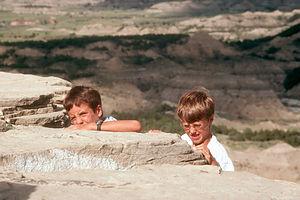 Boys climbing Theodore Roosevelt ParkWe took the trail down from the Visitor Center to hike the loop trail through the Painted Canyon. This really was wild country and so remote that you felt like you had it all to yourself. We could see that we were really going to like this place.
Boys climbing Theodore Roosevelt ParkWe took the trail down from the Visitor Center to hike the loop trail through the Painted Canyon. This really was wild country and so remote that you felt like you had it all to yourself. We could see that we were really going to like this place.
Back in the Visitor Center after our hike, Tommy wandered over to the nature book section and starting poring over the many field guides they had on display. This was something new and something I definitely wanted to encourage. After much deliberation, he selected the Peterson Field Guide to Animal Tracks, and spent the rest of the day with his nose buried in the book, blurting out interesting information as he read along. This loss of his little brother to a book started to bug Andrew, who chose to support Tom's new-found hobby by singing a song about "Nature Tom." After we pulled Tommy off of Andrew's neck, we strongly suggested that they try to enjoy animal tracking together.
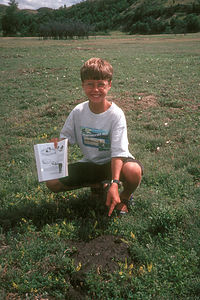 Tom with Bison ScatWe stopped at the Medora Visitor Center in the park and took the brief tour of the Maltese Cross Cabin, which was used by Teddy Roosevelt during his ranching days here. Apparently, Roosevelt came here in 1883 to hunt bison and then eventually went into a partnership on a cattle ranch. He loved these badlands so much that he said he wouldn't have been president if it hadn't been for his experiences here. Fortunately for us, the park is so remote and unspoiled that it hasn't changed much from the days that Roosevelt spent here.
Tom with Bison ScatWe stopped at the Medora Visitor Center in the park and took the brief tour of the Maltese Cross Cabin, which was used by Teddy Roosevelt during his ranching days here. Apparently, Roosevelt came here in 1883 to hunt bison and then eventually went into a partnership on a cattle ranch. He loved these badlands so much that he said he wouldn't have been president if it hadn't been for his experiences here. Fortunately for us, the park is so remote and unspoiled that it hasn't changed much from the days that Roosevelt spent here.
We decided to stop at our campground for lunch so that we could select a site before taking the scenic drive through the park. As usual, I had my campground reservation papers ready, happy knowing that we would have a place to stay. Herb was quite amused as we pulled into the totally empty Cottonwood Campground and had our choice of any site we wanted. After a brief drive around the entire campground, we agreed on the perfect site, nestled among the cottonwood trees overlooking the Little Missouri River. Upon closer inspection we noticed that there was one problem, or advantage depending on how you looked at it. A very large bison was lying in the grass alongside the river about 50 feet away, totally disinterested in the fact that he had new neighbors. I at first questioned the wisdom of this site, but was quickly overruled by "Nature Tom" and his new partner. What better place to start animal tracking.
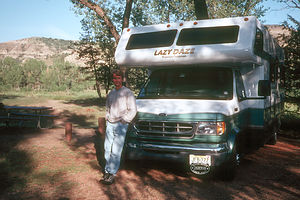 Herb with Lazy DazeAndrew and Tom immediately wanted to go down to the river and look for tracks, but I was a little nervous about this large bison charging them or something. We stopped a ranger driving by and asked him about the bison. "Oh, that's George," he replied. "He lives here." He then explained to us that George was an old bull kicked out of his herd by the younger male bulls. Apparently, that's the destiny that awaits all male bison. Rather than fearing George, I now felt sorry for him and wanted to invite him over for dinner or something.
Herb with Lazy DazeAndrew and Tom immediately wanted to go down to the river and look for tracks, but I was a little nervous about this large bison charging them or something. We stopped a ranger driving by and asked him about the bison. "Oh, that's George," he replied. "He lives here." He then explained to us that George was an old bull kicked out of his herd by the younger male bulls. Apparently, that's the destiny that awaits all male bison. Rather than fearing George, I now felt sorry for him and wanted to invite him over for dinner or something.
On the path down to the river, Tommy found a large animal track, which he immediately began to study. He got down on his knees, methodically analyzing and measuring it and comparing it to tracks in his field guide, obviously truly enjoying himself. "Maybe elk or moose," he mumbled. At this point, his ever faithful brother picked a tuft of bison hair from the track and yelled, "It's a bison track, you idiot, and it's right over there!" This triggered another one of our talks with Andrew about being supportive of his little brother.
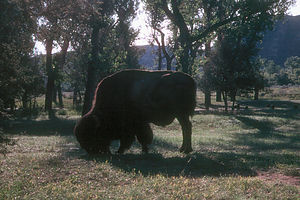 George, the lonely bisonWe decided it was time to take the scenic drive through the park. Our first stop was a prairie dog town, where we watched cute little prairie dog heads popping up out of hundreds of mounds in a field. Apparently, there is an intricate system of tunnels underground connecting these holes, creating an entire city for these little creatures. Along the edge of prairie dog town, the kids performed their first "scat" identification of an animal. We found prairie dog turds, bison pies, elk droppings, and much more. Now Andrew was getting into it.
George, the lonely bisonWe decided it was time to take the scenic drive through the park. Our first stop was a prairie dog town, where we watched cute little prairie dog heads popping up out of hundreds of mounds in a field. Apparently, there is an intricate system of tunnels underground connecting these holes, creating an entire city for these little creatures. Along the edge of prairie dog town, the kids performed their first "scat" identification of an animal. We found prairie dog turds, bison pies, elk droppings, and much more. Now Andrew was getting into it.
We continued our drive stopping to hike the Ridge Trail and Buck Hill. It really was beautiful country--so unspoiled and remote. There was nobody here--nothing like our previous experiences at national parks and surely not what we would find at Yellowstone.
That night back at the campsite, we actually got some real neighbors, an elderly couple from Phoenix traveling on a Honda Gold Wing, complete with a little trailer for their camping gear. I know that is what Herb has planned for me some day when the kids are grown and gone. I told him to be careful or George's fate was what I had planned for him.
After dinner, rather than going back in the RV to watch TV, the kids stayed out with us, passing the time talking and whittling poker chips out of cottonwood branches. These chips are still in the RV--a treasured memory of the brief but special time we had spent here. The evening was perfect--filled with a sense of contentment.
Nothing had prepared us for the way we would feel about the badlands of North Dakota. We had no special expectations about our visit here--it was merely a stop along the way to Glacier National Park. Yet something about the remoteness and rugged beauty of this strange land touched us in a way that few places ever would again.
Description
Theodore Roosevelt National Park encompasses more than 70,000 acres of the rugged badlands of North Dakota. This strange landscape is the result of a process that began more than 60 million years ago when sediment washed down from the young Rocky Mountains and covered the dense vegetation on the Great Plains, turning it into lignite coal. Sometimes this lignite would ignite, baking the gray clay above it into a reddish material known as scoria. As sediment continued being deposited, the Little Missouri River and its tributaries carved and sculpted the softer strata into the buttes, tablelands, and valleys that you see in the park today. The alternating process of depositing sediment and erosion resulted in the multicolored horizontal stripes you see running across them.
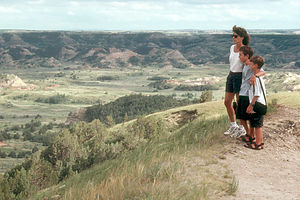 Theodore Roosevelt Park overlookA first place to experience the beauty of the badlands is at the Painted Canyon Visitor Center and Overlook, 7 miles east of Modora, where there is a magnificent panoramic view down into the strange colorful mounds that make up the badlands. There is also a short loop hike from here that goes down into Painted Canyon.
Theodore Roosevelt Park overlookA first place to experience the beauty of the badlands is at the Painted Canyon Visitor Center and Overlook, 7 miles east of Modora, where there is a magnificent panoramic view down into the strange colorful mounds that make up the badlands. There is also a short loop hike from here that goes down into Painted Canyon.
The park is divided into a North and a South Unit, neither one of which ever gets crowded because of the remoteness of this park. The entrance to the more accessible South Unit is located right off 94 in the town of Modora. Near the Visitor Center you can tour the Maltese Cross Cabin, which is the cabin that was used by Teddy Roosevelt when he was a cattle rancher here back in the 1880s. Teddy Roosevelt spent much time here as a young man, hunting and working his ranch. He came to love and respect the badlands and said that without his experiences here he would never have been president. The park was named in his honor because he did more for the National Park System than any other president. The South Unit also has a 36-mile scenic drive which takes you onto a high plateau for excellent views of the badlands. There are overlooks and places to hike along the way.
The even more remote North Unit of the park is located about 50 miles north. It too has a scenic drive that winds through badlands considered by some to be even more beautiful than those in the South Unit.
Jamestown - KOA
Tuesday, July 18, 2000 - 10:00am by Lolo432 miles and 8.5 hours from our last stop - 1 night stay
Travelogue
After a long day driving from Wisconsin through Minnesota and into North Dakota, we were ready for a break. I didn't know anyone that had ever been to North Dakota, so it felt kind of exciting being in real cowboy country.
After a refreshing swim in the campground pool, Herb and I decided that we should go for a run. Usually at home we run at least 5 times a week, but on the road it's difficult to find the time. We have to really make a conscious effort to schedule one in.
Anyway, the kids decided to accompany us on their bikes. The campground was located in the middle of nowhere, so we headed away from the highway onto a long country road alongside some farmland. It was fun because it felt so different from the roads back home. Unlike our winding tree-lined streets, these roads were straight as an arrow and so wide open that you could see for miles in every direction.
After a mile or so we came to a farmhouse. How pretty and quaint I thought--like a typical tourist--until I noticed the two very large dogs on the porch staring at us. From the look they gave us, I had the feeling that lycra-clad runners were probably not a common sight for them. Remain calm I thought, praying that they had one of those invisible doggy fences that every dog owner in New Jersey has. Who was I kidding--this was the wide open spaces of North Dakota. Not being dog people, we all began to get quite nervous. Luckily for us, just as the dogs were about to make their move, two small children came out of the farmhouse and called them back. We waved a hello and thank you and made a beeline back to the safety of the KOA.
One of the things I like best about traveling is the chance to see how different parts of the country live and to have the kids realize that not every place is like their home town. That's what makes things interesting.
Description
KOA Campground in Jamestown, North Dakota, on frontage road right off I94 with nice heated pool.
Apostle Islands National Lakeshore
Monday, July 17, 2000 - 9:00am by Lolo242 miles and 5.5 hours from our last stop - 1 night stay
Travelogue
Our drive to Apostle Islands took us across the rather remote Upper Peninsula of Michigan and into Wisconsin. Along the way, I couldn't help but notice dozens of signs inviting us to stop in for the best "pasties" in the U.P. Now my curiosity was up--what the heck was a pasty? When we stopped at the Visitor Center in Bayfield, I was determined to find out. Herb was quite entertained when I asked the ranger what a pasty was, pronouncing it with a long a, like the little things that strippers wear on their breasts. The ranger tactfully corrected my pronunciation--apparently it's pah stee--and explained that it was a meat pie, a very traditional and popular dish in this region. Now I was mad that we hadn't stopped to try one when we had the chance--I hate being an ignorant tourist.
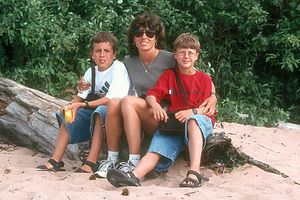 Lorry and boys at Apostle Islands beachWe took a ride up to Little Sand Bay along the Lake Superior shoreline to check things out. The day was pretty cool and dreary so we decided against trying to launch the blow-up boat to explore the islands and sea caves. Normally this might have been a big disappointment, but we had had such a great time out on the boat the previous day at Pictured Rocks that we didn't feel compelled to take it out in what were pretty lousy conditions.
Lorry and boys at Apostle Islands beachWe took a ride up to Little Sand Bay along the Lake Superior shoreline to check things out. The day was pretty cool and dreary so we decided against trying to launch the blow-up boat to explore the islands and sea caves. Normally this might have been a big disappointment, but we had had such a great time out on the boat the previous day at Pictured Rocks that we didn't feel compelled to take it out in what were pretty lousy conditions.
Unfortunately, I'm afraid we didn't do Apostle Islands justice. On a beautiful day with a sea kayak to explore the islands, this place would have been paradise.
We headed back to our campground in Bayfield and decided to just relax and have a nice dinner and maybe watch a movie. While we were making dinner, we were startled when the owner of the campground knocked on our RV. "Do you like country music?" he asked with a big grin on his face. Rather a random question, we thought. Somewhat taken off guard, and never known for his tact, Herb replied, "Not particularly." "Oh, well I'll be performing some in about an hour right out there," he said pointing to two giant speakers next to the campground office. First the pasty thing, and then this. We really have to work at blending in with the locals better.
Description
The Apostle Islands National Lakeshore, which is the northernmost point in Wisconsin, encompasses 11 miles of Lake Superior shoreline as well as 21 remote islands off the Bayfield Peninsula. It has miles of pristine sand beaches, sandstone cliffs, spectacular sea caves, and six historic lighthouses to explore.
While there are some hiking trails in the park, the more popular recreational activities center around the water, such as boating, sea kayaking, scuba diving, and fishing. The waters of Lake Superior are generally too cold for swimming, except in shallow, protected bays.
The main Visitor Center is located in the city of Bayfield, just south of the Lakeshore. Bayfield contains most of the other facilities needed for a visit to the Apostle islands: marinas with boat rentals, a boat launch, the Apostle Island Cruise Service which offers excursion trips to the islands, a water taxi service, and campgrounds. There is another visitor center and boat launch in the park at Little Sand Bay.
The only overnight facilities in the park are campsites on the islands, which can be reached by boat, sea kayak, or water taxi. A permit, which can be acquired in advance, is required to camp on the islands.
Pictured Rock National Lakeshore
Sunday, July 16, 2000 - 9:00am by Lolo180 miles and 5 hours from our last stop - 1 night stay
Travelogue
Pictured Rocks has the unique distinction in my memory of containing both one of our all time vacation low points as well as one of our all time vacation highlights all within the span of one afternoon.
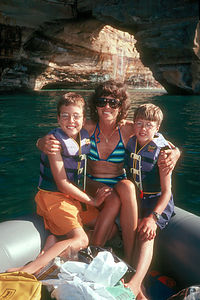 Spouse and boys on raftThe day started off innocently enough with the scenic drive across the impressive 5-mile long Mackinaw Bridge into the Upper Peninsula of Michigan. Not knowing much about Pictured Rock, we headed to the visitor center in Grand Marais at the east end of the park to get some information and ideas as to what to see and do. The good news was the Lakeshore contained 40-miles of Lake Superior shoreline with colorful sculptured cliffs ("picture rocks") rising 50 to 200 feet above the lake. The bad news was there were only 3 points along the shoreline that you could get to by car, and they were only reached via the 30-mile long sandy road that ran from the eastern end of the park.
Spouse and boys on raftThe day started off innocently enough with the scenic drive across the impressive 5-mile long Mackinaw Bridge into the Upper Peninsula of Michigan. Not knowing much about Pictured Rock, we headed to the visitor center in Grand Marais at the east end of the park to get some information and ideas as to what to see and do. The good news was the Lakeshore contained 40-miles of Lake Superior shoreline with colorful sculptured cliffs ("picture rocks") rising 50 to 200 feet above the lake. The bad news was there were only 3 points along the shoreline that you could get to by car, and they were only reached via the 30-mile long sandy road that ran from the eastern end of the park.
We really didn't want to come all this way without seeing the pictured rocks so we decided to take the unpaved road. Our goal was to get to Miner's Beach on the west end of the Lakeshore to at least see the pictured rocks and hopefully either swim or launch our inflatable boat to get a better view of the cliffs. We knew our chances of boating were slim because Lake Superior is more like an ocean than a lake, and usually not the place for a small boat such as ours.
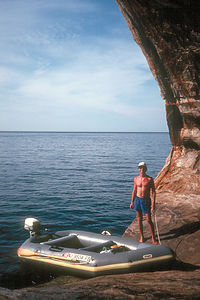 Herb with Avon RedshankThe road didn't start off too bad--that was just its evil way of luring us into complacency until it was too far to turn back. For awhile, we were able to bounce along at about 20 mph on the hard packed sand. About 10 miles into our journey, the road worsened becoming a continuous series of washboard-like bumps, causing everything that wasn't bolted down in the RV to bounce around madly. We had to reduce our speed to 5 mph. I remember following our route on the map on our laptop/GPS setup and watching the excruciatingly slow progress of the little arrow (that represented our motor home) moving along our planned route. I eventually had to turn the laptop off because the jarring was risking doing damage to our hard drive. Four agonizing hours later, with nerves completely shattered, we reached the pavement near the turnoff for Miner's Beach. By this point, Herb hated this park so intensely, that it took some convincing to get him to spend even one more minute here and drive down the short paved road to the Miners Castle Overlook.
Herb with Avon RedshankThe road didn't start off too bad--that was just its evil way of luring us into complacency until it was too far to turn back. For awhile, we were able to bounce along at about 20 mph on the hard packed sand. About 10 miles into our journey, the road worsened becoming a continuous series of washboard-like bumps, causing everything that wasn't bolted down in the RV to bounce around madly. We had to reduce our speed to 5 mph. I remember following our route on the map on our laptop/GPS setup and watching the excruciatingly slow progress of the little arrow (that represented our motor home) moving along our planned route. I eventually had to turn the laptop off because the jarring was risking doing damage to our hard drive. Four agonizing hours later, with nerves completely shattered, we reached the pavement near the turnoff for Miner's Beach. By this point, Herb hated this park so intensely, that it took some convincing to get him to spend even one more minute here and drive down the short paved road to the Miners Castle Overlook.
He was fried. He didn't even want to get out of the motor home to the see the cliffs. The kids and I walked out to the fenced-in overlook and got our first glimpse of the "pictured rock" cliffs dropping off into the aquamarine waters of Lake Superior, which were uncharacteristically like a sheet of glass. It was an awesome sight. As Herb reluctantly approached the overlook, I turned to him and said, "You're gonna wanna launch the boat," which has since become our rallying cry whenever we see spectacular rivers, lakes, or oceans to launch our boat in.
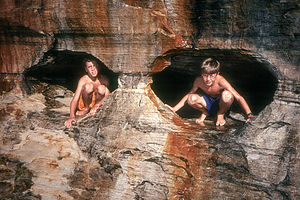 Boys in Pictured Rock EyesI think Pictured Rocks was trying to make up for the ordeal it put us through by giving us the gift of calm waters so that we could explore the cliffs in our inflatable. We lost no time. We quickly drove down to the Miners Beach to set up.
Boys in Pictured Rock EyesI think Pictured Rocks was trying to make up for the ordeal it put us through by giving us the gift of calm waters so that we could explore the cliffs in our inflatable. We lost no time. We quickly drove down to the Miners Beach to set up.
We had packed our12-foot Avon inflatable raft and 6 hp motor on this trip in the hopes that we would come across some opportunities to use it. The raft was stored in a big bag at the foot of the kids' bed over the cab, the wooden floorboard was stored next to the refrigerator, and the 6 hp motor was attached to the back ladder of the RV often eliciting inane comments from strangers, such as, "Can that little motor really power this big vehicle," as if we were some kind of Magic School Bus.
Like a precision team, desperate to extract some fun from the depths of despair, we setup and launched the raft in under a ½ hour. We putted happily along a 4-mile stretch of the pictured rocks between Miner's Castle, a beautiful rock formation in the shape of a castle, and Mosquito Beach. Along the way, we cruised through arches carved out of the cliffs, stopped in caves, and experienced some of the best views the park had to offer. At Mosquito Beach we splashed around in the waters where the Mosquito River flowed into Lake Superior. It was a fabulous experience--worth every bounce along our way here.
Back at Miners Beach while putting away the raft, the fickle Pictured Rocks tried to turn on us again. Our first suspicion that something bad was coming was the approach of a couple strolling along the beach clothed in full mosquito netting from head to toe. How ridiculous we all thought, but as dusk approached we ate our words. We became so covered in mosquitoes that we could barely carry the raft back to the RV because we had to constantly stop to slap the mosquitoes off.
However, not even the mosquitoes could put us in a bad mood after the great day we had had out on the lake.
Description
Pictured Rock National Lakeshore, on Michigan's Upper Peninsula, encompasses 40 miles of sandstone cliffs, beaches, and dunes along Lake Superior's southern shoreline. The name "pictured rock" comes from the colorful streaks of mineral stains that decorate the face of these colorful sculptured cliffs, which tower 50 to 200 feet above the aquamarine waters of Lake Superior. Erosion from the winds and the waves has sculpted these rocks over time, forming caves, arches, and formations resembling fortresses and castles.
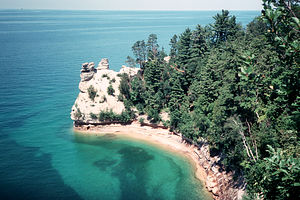 Pictured Rock National LakeshoreThe Pictured Rocks are best seen by boat or by air. However, if that is not an option, the best view of the rocks from land is from the Miners Castle Overlook, where there is an overlook platform directly above a castle-shaped formation in the cliffs. Another way to view the cliffs is to hike along the Lakeshore Trail, which runs the entire length of the park's shoreline.
Pictured Rock National LakeshoreThe Pictured Rocks are best seen by boat or by air. However, if that is not an option, the best view of the rocks from land is from the Miners Castle Overlook, where there is an overlook platform directly above a castle-shaped formation in the cliffs. Another way to view the cliffs is to hike along the Lakeshore Trail, which runs the entire length of the park's shoreline.
The only road through Pictured Rocks is an inland 40-mile sandy road that connects Grand Marais in the northeast with Munising in the southwest. Most of the shoreline itself is inaccessible by car, except for Miners Beach, Twelvemile Beach, and Hurricane River.
Activities at the Lakeshore include hiking, boating, kayaking, canoeing, fishing, and swimming in the somewhat chilly waters of Lake Superior.
Mackinac Island
Saturday, July 15, 2000 - 9:00am by Lolo0 miles and 0 hours from our last stop
Travelogue
My absolute favorite way of exploring is on my bike, so a trip to Mackinac Island, where no cars are allowed, was something I was greatly looking forward to.
 Family at Mackinac IslandWe woke early to a bright sunny day and rode our bikes from the campground to the ferry terminal just a few blocks away. For some reason, having nothing but our bikes beneath us gave us a feeling of freedom, a sense of adventure. Ferries make us happy too--they always seem to take us to special places we learn to love. So needless to say, spirits were high and we were ready for a day of fun.
Family at Mackinac IslandWe woke early to a bright sunny day and rode our bikes from the campground to the ferry terminal just a few blocks away. For some reason, having nothing but our bikes beneath us gave us a feeling of freedom, a sense of adventure. Ferries make us happy too--they always seem to take us to special places we learn to love. So needless to say, spirits were high and we were ready for a day of fun.
Then, to our dismay, while filming our approach to the Island, Herb's camcorder went on the fritz--he couldn't see anything through the viewfinder. This was not good. Immortalizing our vacations on film is a passion with us, so this was not a mere inconvenience but a possible catastrophe. After putzing around with it for awhile, Herb came to the conclusion that the camera was probably recording, but he just couldn't see what the heck he was filming. He would just have to aim and hope that he wasn't just filming the tops of our heads or our feet.
The island was great--a step back in time to the Victorian Age. Horse-drawn carriages were bustling up and down Market Street, the main drag through the historic part of town. We strolled through the town, past its historic buildings and quaint shops--this was right up my alley. Herb wasn't quite as enamored with the quaintness as I was and kept mumbling something about the smell of horse piss. I think he was still in a bad mood about his camcorder.
The kids, however, loved it--especially the fudge shops. I've never in my life seen so many fudge stores, and they all had little tables outside offering free samples--which the kids took great advantage of. After filling our faces with about a pound of free samples, we purchased enough chocolate chip mint and death by chocolate (or some name like that) to last us the rest of our vacation, or so we thought--it was so good, that it never made it past Montana.
Now that we had our fill of fudge, it was time to do some exploring. Having spent many visits to historical forts in the past, we chose to skip the tour of Fort Mackinac and use the time we had on the island to bicycle the 8.2 mile Shoreline Trail, which goes completely around the island.
We first took a side trip up the hill past the fort to Skull Cave, because the name sounded pretty appealing to our 8 and 10-year old boys. According to legend, an English fur trader named Alexander Henry hid out in this cave during an Indian uprising in 1763. Unfortunately for him, the local Indian tribe used the cave to bury its dead, so he had to spend the night sleeping on a bed of skulls. The kids were hoping to see some skulls, but no such luck. If there ever were any, they are now long gone. They did, however, have fun climbing around on the rock above the cave.
We then headed off on the shoreline trail, which, as its name implies, ran right along the shore of the lake, with no cars to deal with, just the occasional horse-drawn carriage. After a short distance, we stopped at Arch Rock, a limestone arch that rises 149 feet above the water and has a span of 50 feet. Very impressive--I hope Herb managed to film it. We spent the next hour or two meandering along the rest of the Shoreline Trail, enjoying the views of the lake. Almost back in town, we rode past the very impressive 1887 Grand Hotel, with its very inviting 660-foot verandah. Unfortunately, it wasn't that inviting--for non-hotel guests, they charge an admission fee to even set your foot on the porch.
Back in town again, we had an early dinner at the Pink Pony Bar and Grill, which we learned is the end destination for the sailors in the Chicago to Mackinac Island sailboat race each year. I can see why. The food was great and the views out over the harbor to Mackinaw Bridge were lovely. It was a perfect ending to a near perfect day.
Description
Mackinac Island, one of Michigan's most popular state parks, is located in the western portion of Lake Huron near where it meets Lake Michigan. A visit to Mackinac Island is like a step back to the Victorian Age. There are no cars on the island--transportation is limited to horse-drawn carriage, bike, or foot. However, that isn't a problem as the island is quite small. In fact, there is an 8.2 mile "round-the-island" shoreline road for biking, hiking, and running.
The island is reached by ferry either from St. Ignace or Mackinaw City. The ferry docks at the southern part of the island in the historic downtown where most of the action is. Here you can stroll along Market Street visiting the historic buildings dating back to the early 1800s when the American fur trade was centered here, or stop in one of the many fudge shops which line the street. To the west of Market Street stands the impressive 1887 Grand Hotel with its 660-foot verandah, which unfortunately only hotel guests are allowed to sit on. In true Victorian fashion, guests receive afternoon tea and are expected to wear formal attire after 6:00 pm.
On a hill 150 feet above the town stands Fort Mackinac, which played an important role in the War of 1812. There are 14 historic buildings to visit within the fort and live history presentations where soldiers costumed in American uniforms from that time recreate military life in the 1800s, complete with music and musket demonstrations.
Past the fort is Skull Cave, which according to legend, is the cave where the English fur trader Alexander Henry hid out during an Indian uprising in 1763. According to Henry, the floor of the cave was covered with the human skulls. Apparently, the local Native Americans, used this cave to bury their dead.
The best way to see the rest of the island is to bike the 8.2 mile trail that runs around the entire island's shoreline. Bikes can be brought over on the ferry or rented right in town. One of the highlights along the shoreline trail is Arch Rock, a natural limestone formation with a span of 50 feet that rises 149 feet above the water. It is one of the most photographed spots on the Island. Other stops include a Nature Center and British Landing, where the British came ashore in 1814 on their midnight raid.
Cherry Orchards Drive / Mackinaw City
Friday, July 14, 2000 - 9:00am by Lolo170 miles and 4 hours from our last stop - 2 night stay
Travelogue
After leaving Sleeping Bear, we decided to take the scenic Cherry Orchards Drive along the shores of Lake Michigan to Mackinaw City.
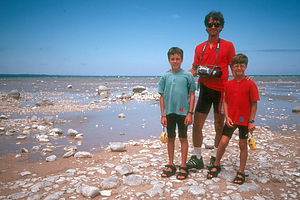 Herb and boys at Old Mission PeninsulaWe took the side drive out to Old Mission Peninsula, which juts out into Grand Traverse Bay. The peninsula road wanders through vineyards and the greatest concentration of cherry orchards in the country. Everywhere you looked there were roadside stands selling cherries and cherry pies. At the end of the road we stopped at the 1870 Old Mission Lighthouse and walked out on a boulder-strewn beach. Right by the lighthouse, there was a sign proudly displaying the fact that we were standing on the 45th parallel, exactly halfway between the Equator and the North Pole.
Herb and boys at Old Mission PeninsulaWe took the side drive out to Old Mission Peninsula, which juts out into Grand Traverse Bay. The peninsula road wanders through vineyards and the greatest concentration of cherry orchards in the country. Everywhere you looked there were roadside stands selling cherries and cherry pies. At the end of the road we stopped at the 1870 Old Mission Lighthouse and walked out on a boulder-strewn beach. Right by the lighthouse, there was a sign proudly displaying the fact that we were standing on the 45th parallel, exactly halfway between the Equator and the North Pole.
Back off Mission peninsula, we drove through pretty lakeside resort towns such as Traverse City and Charlevoix on our way to Mackinaw City, which we were going to use a base from which to explore Mackinac Island.
In Mackinaw City, we stayed at TeePee campground, right on Lake Huron. That evening, we wandered down to the small rocky beach, but none of us was in the mood to swim in the cool lake waters. There were lots of kids running around the campground, so after a little nudging we got the kids to mingle a little and play some volleyball and horseshoes with the other kids.
The next morning we rode our bikes from the campground to catch the ferry to Mackinac Island.
Description
The Cherry Orchards Drive is a 100-mile drive between Sleeping Bear Dunes National Lakeshore and Mackinaw City that winds along the eastern shore of Lake Michigan through lakeside resort towns and cherry orchards.
Mackinaw City is a good base for exploring Mackinac Island. TeePee Campground is conveniently located in biking distance to the ferry.
Sleeping Bear Dunes National Lakeshore
Thursday, July 13, 2000 - 4:00am by Lolo160 miles and 3.5 hours from our last stop - 1 night stay
Travelogue
Because of our long driving the previous day, we got to Sleeping Bear Dunes early enough to make a day of it. The weather was great, so after checking in at the Platte River Campground, we immediately headed to Platte River Point for a swim in Lake Michigan.
 Lorry and boys on bike rideAs we drove along the Platte River, we noticed people in tubes happily floating along the gentle waters of the river. The kids looked on in envy. It was moments like this that made my obsessive over-planning all worthwhile. Not wanting to miss a tubing opportunity like we had last year on the Virgin River in Zion, we had packed inflatable tubes just on the chance that we would come across another tubing opportunity.
Lorry and boys on bike rideAs we drove along the Platte River, we noticed people in tubes happily floating along the gentle waters of the river. The kids looked on in envy. It was moments like this that made my obsessive over-planning all worthwhile. Not wanting to miss a tubing opportunity like we had last year on the Virgin River in Zion, we had packed inflatable tubes just on the chance that we would come across another tubing opportunity.
We parked at the end of the road, right at the point where the Platte River bends to the right for its final stretch before flowing into the lake. Perfect! The kids quickly blew up the tubes and ran up the river and then floated down past us again. It looked like so much fun that I had to join them. Herb, always the avid recorder of great family moments, stayed behind to video us. It really was great fun and the water was so warm.
After a few more runs up the river, we floated down and around the bend between the beach and a spit of sand that protruded out into the lake. When we hit the lake, we were shocked by the difference in water temperature--it was cold! We spent the rest of the afternoon lounging around in the warmer waters right before the river hits the lake.
However, there was more to do at Sleeping Bear than just lounge, and it was staring us in the face. Further north along the shore were these massive dunes rising practically straight up from the lake. They were so high that in the afternoon haze they appeared more like mountains than sand dunes.
Knowing that we just had to climb them, we got in the RV and drove up to the northern end of the park to the Dune Climb parking lot. These were serious dunes. We started our trek up the dune hoping to make it all the way to Lake Michigan, about 1.8 miles away. Every time we thought we were at the top of the dune, it would flatten out for awhile and then rise up some more. The going was slow and the climb seemed endless. Finally, we made it to the top where we could look out over the aquamarine waters of Lake Michigan. Although we were tempted to continue the hike down to the lake, we were becoming concerned about a large thundercloud that was building up over the lake. A little rumbling in the distance convinced us to head back, rather than get caught up on top of a dune during a thunderstorm. This was the rewarding part--all down hill. The kids jumped and rolled and got sand in their hair, in their pockets, and God knows where else. It was great fun. We got back to the RV just as the rain began to fall.
The next morning our plan was to bicycle the 7-mile long Pierce Stocking Drive. We love biking together, but sometimes we forget that Tommy is only 8 years old and riding a Toys R Us bike that weighs more than he does, and this road was quite a challenging ride, even for me and Herb. There were several hills where the kids had to get off and walk their bikes, but they were really good sports about it. The views of the dunes and the lake along the way were really spectacular though. There was one particularly scenic stop on the ride where you could climb down a very steep dune to the shores of the lake. The climb back up looked really difficult. As the kids were already pretty tired from the biking, we decided to pass on it this time--maybe on a future visit. I always like a reason to come back to a place.
Before leaving Sleeping Bear, we stopped at the Sleeping Bear Point Coast Guard Station Maritime Museum in Glen Haven, where there were some interesting exhibits about the shipwrecks and life-saving efforts that occurred in the waters around Sleeping Bear.
Before this trip, we never even thought of Michigan as a travel destination, but we certainly will in the future.
Description
Sleeping Bear Dunes National Lakeshore encompasses 35 miles of Lake Michigan's eastern shoreline, as well as North and South Manitou Islands. The main attractions here are the swimming beaches and the dunes which tower 460 feet above Lake Michigan.
The most popular way to visit the dunes is the very challenging but rewarding Dune Climb. There are three different trails of varying difficulty to choose from. The most difficult one is the 3.5 mile Dunes Trail which goes to Lake Michigan and back. Then there is the 2.8 mile Sleeping Bear Point Trail and the easier 1.8 mile Duneside Accessible Trail.
The Platte River, which runs through Sleeping Bear, is an ideal place for canoeing, tubing, and kayaking. The gentle currents along the section of the river that runs through the park make it a perfect trip for families. The river ends at a beautiful sandy beach on Lake Michigan.
Another favorite activity at the Lakeshore is the 7-mile-long Pierce Stocking Scenic Drive, which winds through dunes and woods, with breathtaking views of Lake Michigan. Bicycles are permitted but it is an extremely hilly and challenging ride.
The Sleeping Bear Point Coast Guard Station Maritime Museum in Glen Haven is an excellent place to learn about the history of the shipwrecks and life-saving efforts that occurred in the waters around Sleeping Bear. Each afternoon, the museum conducts a re-enactment of a life-saving service rescue.
The Platte River Campground in the park has 174 sites, 44 of which are reservable in advance.
Bay City State Recreation Area
Wednesday, July 12, 2000 - 2:00pm by Lolo725 miles and 13 hours from our last stop - 1 night stay
Travelogue
It was great to be on the road again. Spirits were high as we pulled out of the driveway, everyone excited about the prospect of spending the next 3 1/2 weeks touring the U.S.
Our first planned stop was Sleeping Bear Dunes National Lakeshore in western Michigan, about 16 hours away and much too far for a first day drive. We started out around 8:00 in the morning and just drove and drove until we got too tired to go any further. We did much better than we expected and actually made it to Bay City, Michigan (right where the thumb meets the rest of the hand in mitten-shaped Michigan). This left us with only 3 hours of driving to do the next morning, which meant that we would get to Sleeping Bear early enough to make a day of it.
We camped for the night at Bay City Recreation Area, right on Saginaw Bay on Lake Huron. It was already after 9:00 pm when we got there, so all we really had time for was a quick dinner and then bed. The kids had to burn some energy so they took their Razor scooters out and rode them around in the dark. We couldn't see much, but it looked like a very nice campground.
When we drove out the next morning, we took a ride around the campground. There was a nice beach on Saginaw Bay, volleyball courts, hiking trails, and lots of other recreational opportunities. This would have been a nice place to spend another night, but we had no time to linger--we had a whole country to explore.
Description
Bay City Recreation Area is a 193-site campground and recreational park on the shores of Saginaw Bay on Lake Huron. Facilities include swimming beaches, volleyball and basketball courts, fishing dock, Nature Center, golf, and hiking trails.
Home
Wednesday, August 11, 1999 - 11:00am by Lolo627 miles and 11 hours from our last stop - 1 night stay
Travelogue
Ten more hours and we were finally home. Everything seemed so different. After the wide expanses of the west and the plains where the views went for miles and miles, everything seemed so small and closed in. The colors were so different as well. Gone were the yellows and pinks of the desert. Here everything was so green and lush--and unfortunately so humid.
However, as great as it is to travel, it's always a good feeling to be home again. It's the contrasts that make things so interesting.
Too bad our homecoming couldn't have been under happier circumstances.
Description
Our home in Upper Saddle River, a suburb of New York City.
Mesa Verde National Park
Sunday, August 8, 1999 - 9:00am by Lolo190 miles and 4.5 hours from our last stop - 1 night stay
Travelogue
Our next stop was to see the Anasazi cliff dwellings in Mesa Verde National Park. The park's most spectacular cliff dwellings--Cliff House, Balcony House, and Long House--can only be visited during a ranger-guided tour, so we headed right for the Far View Visitor Center to purchase tickets for the ranger-led Balcony House Tour.
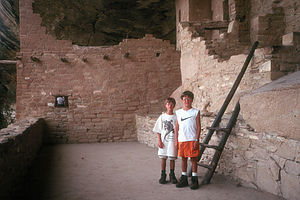 Andrew & Tommy at Mesa VerdeThe tour information had all these warnings for people with claustrophobia or a fear of heights. Apparently we were going to have to climb 32-foot-ladders up the sides of a cliff and crawl through narrow 30-foot-long crawl spaces. I started getting the same queasy feeling that I get before going on an amusement park ride. The kids were amused by my apprehension and just told me to relax.
Andrew & Tommy at Mesa VerdeThe tour information had all these warnings for people with claustrophobia or a fear of heights. Apparently we were going to have to climb 32-foot-ladders up the sides of a cliff and crawl through narrow 30-foot-long crawl spaces. I started getting the same queasy feeling that I get before going on an amusement park ride. The kids were amused by my apprehension and just told me to relax.
To get to the Balcony House we drove the scenic Ruin Drive along the Chapin Mesa, stopping at the numerous view points along the way. It really was hard to believe that these ancient people actually built their homes into the sides of a cliff. They weren't just simple little caves either. Some of the dwellings looked like multistoried apartments with hundreds of rooms.
When we lined up for our Balcony House Tour, I was happy to see that there was a collection of butts much larger than mine that had to crawl through those tiny spaces we had been warned about. I was starting to relax. We were soon joined by our very enthusiastic ranger, who led us down a path to the base of one of those log ladders we had to climb. After a brief demonstration on the do's and don'ts of ladder climbing, the ranger asked Andrew and Tommy to lead. They scooted up the 32-foot-high ladder like little monkeys, making it look easy. It really wasn't bad at all. Our ranger spent the next hour leading us though crawl spaces and up and down ladders through the various rooms of this amazing dwelling. Along the way, he painted a picture for us of what life was like for the Anasazi people that inhabited these dwellings more than 800 years ago. Every once in awhile we are lucky enough to come across a ranger that truly loves what he is doing and whose enthusiasm is contagious. This was one of those lucky times and it definitely made for a more interesting and fun tour.
After the tour we headed over to the Chapin Mesa Museum where we learned more about the Anasazi and their fascinating life on the mesa. Andrew had just finished studying Native American culture in his 4th grade Social Studies class, so I think he got a kick out of seeing the real thing. From behind the Chapin Mesa Museum, we hiked the 1/4 mile trail to the Spruce Tree House, the park's best preserved ruin and the only one that you can visit on your own. We even got the chance to climb down a ladder through a smoke hole into a kiva, which was an underground ceremonial room.
Back at the museum we found out that in a few minutes there was going to be a genuine Hopi Indian ceremonial dance, which was something that happened here only once or twice a year. This was our lucky day--first the enthusiastic ranger and now dancing Hopi. We quickly headed down to the small amphitheater to catch the show, which was fascinating to watch. I always wonder if these ceremonies and rituals are still a part of their modern-day life or just a live history demonstration of past customs. I really hope that it's still a part of their culture today.
Description
Mesa Verde National Park, located in the very southwestern corner of Colorado, is an 80-square-mile mesa that rises 1,600 feet above the surrounding desert and river valley. It is the largest archaeological preserve in the U.S. with more than 4,000 Ancestral Puebloan (Anasazi) archaeological sites dating from 550 to 1270 AD. These sites include some of the largest cliff dwellings in the world, mesa-top pueblos, pit houses, and kivas (underground ceremonial rooms).
The Anasazi, which is a Navajo word meaning "ancient ones," began settling here in mesa-top pueblos around 750 AD. These peaceful and highly religious people were mostly farmers and potters. Around 1200, they moved their village down into the recesses of the cliffs and built multistoried apartment-style dwellings, often containing up to 400 rooms. By the middle of the 13th century, the mesa was a bustling trade center with a population of about 5,000 people. Then for some unknown reason, around the latter part of the 13th century, the pueblos were abandoned. Archaeologists are not sure why or where the Anasazi went. It is thought that the Hopi and other Native American tribes in the Four Corners area are descendants of these ancient cliff dwellers.
The major cliff dwellings were first seen by white settlers in 1888 when two ranchers, Richard and Charles Wetherill, were riding across the mesa in search of stray cattle. When they peered over the rim, they were shocked to see multistoried cliff dwellings build into the alcoves of the cliffs more than 2,000 feet above the valley floor. They climbed down to explore the deserted village, which they named Cliff Palace. In its 200 rooms and 23 kivas, which had been uninhabited for over 700 years, they found stone tools, pottery, baskets, and other artifacts. When word got out of their discovery, treasure hunters came in droves in search of valuable artifacts. In order to protect these treasures, President Theodore Roosevelt signed a bill in 1906 creating Mesa Verde as a National Park.
Three of the park's cliff dwellings can be visited on ranger-guided tours--Cliff Palace, Balcony House, and Long House. Tickets for these tours, which are quite inexpensive, can be purchased at the Far View Visitor Center. You can also take the ¼ mile trail from the Chapin Mesa Museum for a self-guided tour of the Spruce Tree House, which is the park's best preserved ruin. Here you can climb down a ladder through a smoke hole into a kiva.
